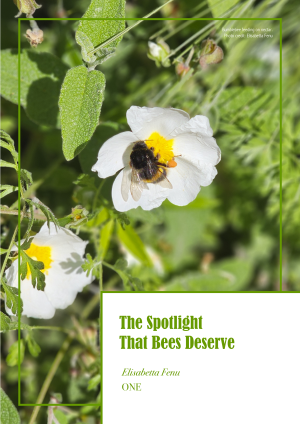 Bees keep carrying the weight of the world on their wings. They managed to survive a significant mass extinction event and multiple smaller ones; bees still grace our environment today.
Bees keep carrying the weight of the world on their wings. They managed to survive a significant mass extinction event and multiple smaller ones; bees still grace our environment today.
You learn about bees in kindergarten. They appear in books, figures, and medicine boxes. Bees live on many continents, and they’re one of the most popular animals in the world. However, their key role in the ecosystem isn’t fully appreciated. Not because people don’t know them enough but because education is lacking regarding the environment and its processes. To truly understand the importance of bees, they must be put into context.
The dance of evolution
Pollinators include many animals, such as wasps, flies, ants, and even some vertebrates. All of them are precious, but bees are the most efficient, and with their decline, the entire pollination network could be disrupted. So, what is pollination? It’s the way flowering plants transfer genetic material between individuals of the same species. This allows them to reproduce, thereby spreading seeds and promoting genetic diversity. It is well known that genetic diversity makes species more resilient to environmental changes and diseases, thereby ensuring their survival.
Pollinators serve as catalysts in turning arid lands into thriving ecosystems, which is why they are so essential to biodiversity. If most bee species were to disappear, pollination would be significantly less effective, thereby reducing biodiversity and lowering the resilience of many plants and crops, ultimately leading to the loss of those species.
In 2017, the UN General Assembly declared World Bee Day to be celebrated on May 20, the day on which Anton Janša, a pioneer of modern apiculture, was born. The goal is to raise awareness of the role of pollinators and their contribution to the environment.
The main threat to pollinators is, directly or indirectly, humans. “Wild pollinators have declined in occurrence and diversity (and abundance for certain species) at local and regional scales in Northwest Europe and North America”, says IPBES in its famous report “The assessment report on pollinators, pollination and food production” (2016), the document that prompted the UN to establish World Bee Day. More data is needed to estimate the global decline of pollinators, but one thing is sure: the threats are real.
Solitary vs social bees
Social bees, such as honeybees (Apis mellifera), are by far the most popular species. While they deserve all the credit, there are over 20,000 known species, and more than 90% of them are solitary. Solitary bees don’t create the classic hexagon-shaped cells in their nest and don’t produce large quantities of honey because they don’t belong to any hive. Each female builds her own nest, usually burrowed into soil or pre-existing cavities, and collects pollen and nectar for her offspring. This characteristic is one of the major factors that determined the survival of bees during the K-Pg (Cretaceous-Paleogene) mass extinction, when an enormous asteroid hit the Earth’s surface, wiping out non-avian dinosaurs and many other species. The impact instantaneously released a deadly amount of energy and altered the Earth’s atmosphere.
Solitarybees’ tendency to burrow their nest into soil allowed many lineages to survive and contribute to restoring the Earth to the lush world we know today. Since solitary bees spend a lot of time in the soil, they are excellent soil health indicators.
What distinguishes social bees from solitary ones is their ability to organise at the highest level of sociality. This skill is called eusociality and has evolved among crustaceans, insects and mammals. Eusociality is what allows honeybees or bumblebees to organise in colonies by sharing a single nest and working with a precise hierarchy. Bees are haplodiploid. Therefore, the sex of the offspring is determined by the female (diploid), who can “choose” whether to fertilise the egg or not with the genetic material coming from the male (haploid). If the egg gets fertilised, then the offspring will be female (2 sets of chromosomes); if the egg is not fertilised, it will become a male (1 set of chromosomes).
In social bees, the only fertile female in the colony is the queen, and she gets to “choose” the sex of her offspring based on current needs. Most of the colony is composed of sterile females, also called “worker bees”, which are closely related to each other – 75% of shared genetic material on average – precisely because of haplodiploidy. This system not only functions as a regulatory mechanism for the colony, but it also promotes cooperation between worker bees and allows the queen to eliminate harmful mutations, if necessary, quickly. Social bees can produce a considerable amount of honey, a thick, sugary food source that is highly beneficial for humans as well. It can be eaten directly or used for its medical properties. Honey is what led humans to pursue apiculture, the practice of keeping and managing bee colonies.
Apiculture is a perfect tool for promoting sustainability and environmental preservation: it helps maintain strong bee populations, ensuring pollination and biodiversity; it provides a sustainable source of income for rural areas and war-torn regions; and it serves as a valuable laboratory for studying bee behaviour or analysing the health of the local environment. Indeed, bees can travel up to 5km from their nest, collecting pollutants and other substances along with nectar and pollen. Analysis of honey and wax of a nest enables scientists to determine the health of the environment. This way, preventive measures can be implemented immediately to help maintain ecosystem stability. In 2018, a colony of honeybees was utilised to check air pollution in Rome. This project has also been previously implemented in London, Tokyo, and New York.
The sixth mass extinction
The current extinction rate of several families of plants, mammals, birds, reptiles and amphibians is estimated at 100 to 1,000 times higher than the natural background extinction rate. It’s the clear signal of what many experts call the “sixth mass extinction”, following the “big five” that unfolded over the course of Earth’s history. The current extinction is, without a doubt, caused by human activity. Bees are suffering, too. Loss of habitat, pesticides, pollution, diseases and climate change present a serious threat to pollinators.
During the last World Bee Day, a lot of emphasis was put on crop pollination. Pollinators contribute to the production of about 70% of the 115 leading global food crops. If bees partially disappeared, diets would change drastically. Many populations would have to rely on other crops, mainly rice or potatoes, but that wouldn’t guarantee the consumption of necessary nutrients. Biodiversity would dramatically decline, making humans and other species even more vulnerable to climate change. When considering an environmental issue, it is easy to think of it as isolated; however, threats come from multiple fronts.
A new study suggests that increasing levels of carbon dioxide in the atmosphere favour the absorption of inorganic arsenic in rice crops. So, if humans relied mainly on rice, diseases like cancer would be much more common. This is how an ecosystem works. Factors are entangled. Less biodiversity means less carbon sequestration from plants, which would lead to increasing levels of CO2, thereby restarting the cycle. Solutions suggested during the 2025 World Bee Day include the creation of pollinator gardens, the implementation of pesticide bans, and the promotion of beekeeping, also known as apiculture.
It’s essential to remember that without bees – the “unsung climate heroes” – the advance of the sixth mass extinction isn’t just possible, it’s inevitable.
Elisabetta Fenu





